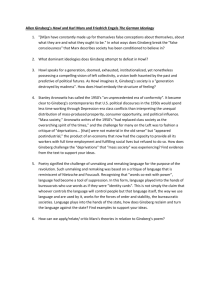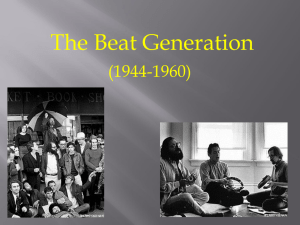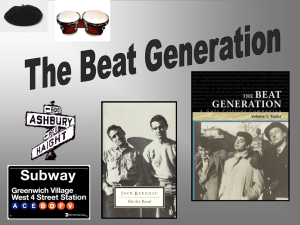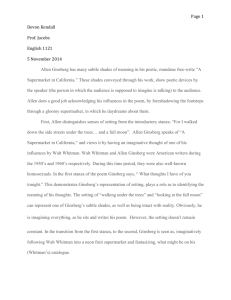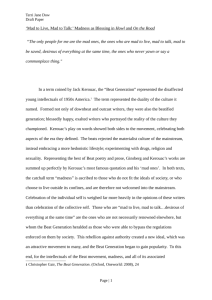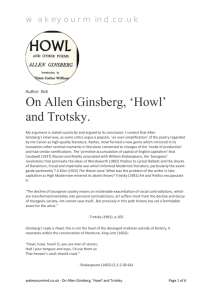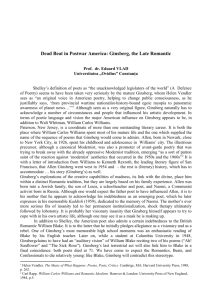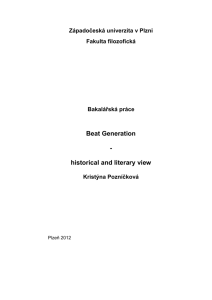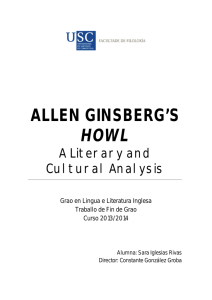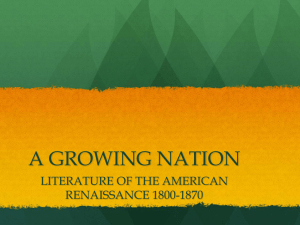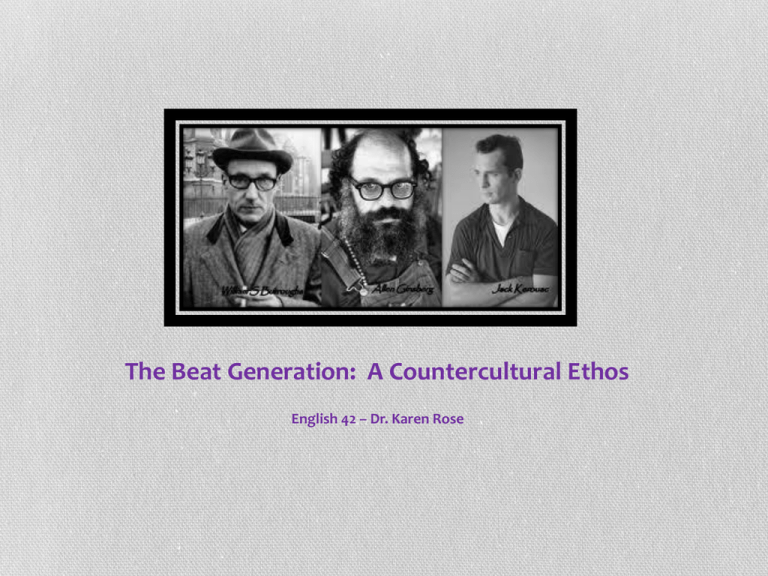
The Beat Generation: A Countercultural Ethos
English 42 – Dr. Karen Rose
“The Beat Generation” is a term that applies to a group of American poets
and novelists of the 1950s and 1960s who rebelled against American culture
and values.
They viewed the United States as conservative, imperial, and constrictive.
The atom bomb, the war in Vietnam, and ecological pollution were sources
of great concern that fueled their unease and disillusionment. For the
young generation, it was an “age of anxiety.”
The writers’ disillusionment also stemmed from pervasive features of the
U.S. social and economic order: bureaucratic impersonality, material glut
and waste, the sense of powerlessness in relation to the large
organizations within which a person typically works, the feeling of being
manipulated by advertising and publicity.
A backyard bomb shelter in 1955. Garden City, New York.
To many writers of the Beat Generation, it seemed that Western
civilization and its cultural ideas were spiritually bankrupt.
The writers who identified with the Beat Generation scorned the complacent,
hypocrisy of American Life.
They felt that America was a place that stifled individuality.
Beat Generation writers expressed their revolt in works that were loosely
structured, employed slang and vulgar diction, and included images of graphic
sexuality. The tone was one of rebellion and expressed a state of mind
embodied in the Bohemian atmosphere of New York City’s Greenwich Village
and San Francisco’s North Beach and Haight Ashbury.
Leaders of the movement were Jack Kerouac, Allen Ginsberg, William
Burroughs, Lawrence Ferlinghetti, Gary Snyder, Gregory Corso. There were no
people of color; there were no women. In fact, the Beat Generation authors are
often accused of being chauvinist, even misogynist.
The term “beat” was coined by Kerouac for its punning reference to “beaten
down” and “beatified.”
“Beaten down” suggests exhaustion, being at the bottom of the world.
“Beatified” has a religious implication, as in a “beatific vision.” In Christian
theology, this means seeing God face to face – not imperfectly through faith. A
beatific vision occurs when a human soul is actually looking at God.
Hence, “beat” takes on a connotation of blessedness, a state of exalted
exhaustion. For more on this, see John Clellon Holmes, “The Philosophy of the
Beat Generation.”
The concept of illumination was central to their view of life. It might result
from drunkenness and abandon, from hallucinogenic drugs such as peyote
and LSD, from sexual ecstasy, from Buddhism, from live jazz music, from
anything that increased the sensation of a heightened receptivity to life.
Their goal was release – from the confines of social and moral judgment, from
a conformist and materialistic society, and from the conventions of literature.
Jack Kerouac
Jack Kerouac was one of the first writers to bring the Beat Movement into
public attention. Born in 1922 in Lowell, Massachusetts, Kerouac was an
excellent athlete who earned a football scholarship to attend Columbia
University.
In New York City, he met William Burroughs and Allen Ginsberg.
On the Road (1957) and The Dharma Bums (1958) are the most popular of
Kerouac’s many novels.
Jack Kerouac’s Typewriter
Kerouac did not write using pen and paper; he used a typewriter.
Convinced that his “verbal flow” was hampered when he had to change
paper at the end of a page, Kerouac taped together 12 foot-long sheets of
paper and fed them into his typewriter as a continuous roll. When he was
done, he taped them together to form a 120 foot scroll, and this was On
the Road. This unique method of composition facilitated what he called
“spontaneous writing.” To see a video of the legendary scroll unrolled,
click here: http://youtu.be/WmyS1EEVFbs The scroll was purchased by Jim
Irsay, owner of the Indianapolis Colts in 2001 for $2,200,000.
Kerouac in the Merchant Marines
Published when Kerouac was 37 years old, On the Road is now regarded as
one of the best expressions of the Beat Generation’s way of life. The young
generation of the late 1940s is presented as a group of people in constant
flux; they are restless and, fueled by drugs and alcohol, searching for “It.”
On the Road also is often discussed as a study of the promise and
shortcomings of America, a nation where “everybody’s doing what they
think they are supposed to do” (On The Road, page 68)
On the Road is a 5-part, first-person narrative . A young writer, Sal Paradise,
describes 4 road trips across the United States and into Mexico that he took
between 1946 and 1950.
At the center of the novel is Dean Moriarty, the exemplar of Beat life. A freespirited social misfit, Dean is a fast-talking womanizer who possesses a
heightened sense of adventure. Dean is interesting, but because he lives in the
moment, he is unpredictable and unreliable.
Jack Kerouac and Neal Cassady, the model for Dean Moriarty
While Sal sees Dean’s limitations, he admires Dean’s “ragged and ecstatic joy
of pure being.” Dean is the “HOLY GOOF,” “the root, the soul of Beatific”
who possesses “the secret that we’re all busting to find.”
While Kerouac never clearly articulates what “the secret” is, On the Road’s
anecdotes and images from life off the beaten path of American experience
speak for themselves.
Most famous quote from On the Road.
“But then they danced down the street like dingledodies, and I shambled
after as I've been doing all my life after people who interest me, because the
only people for me are the mad ones, the ones who are mad to live, mad to
talk, mad to be saved, desirous of everything at the same time, the ones who
never yawn or say a commonplace thing, but burn, burn, burn, like fabulous
yellow roman candles exploding like spiders across the stars and in the
middle you see the blue centerlight pop and everybody goes ‘Awww!’”
Bob Dylan and Allen Ginsberg at Kerouac’s grave
Kerouac died at age 47 of an internal hemorrhage related to his alcoholism.
At the time of his death, he was living in St. Petersburg, Florida with his ailing
mother and his third wife. He is buried in his home town of Lowell,
Massachusetts.
A film version of On the Road starring Sam Riley, Garret Hedlund, Kristen
Stewart, Kirsten Dunst, Amy Adams, and Viggo Mortensen is scheduled to be
released in 2012!!!! This is the first film adaptation of the novel.
Watch the trailer here: http://youtu.be/N9vsE0llyBM
Allen Ginsberg
Allen Ginsberg was born in 1926 in Newark, New Jersey. His father, Louis, was a
poet and a high school English teacher; he was a conservative man who wrote
“timid, conventional verses.” His mother, Naomi, was politically radical,
idealistic, and emotional.
When Ginsberg was 12 years old, his mother became delusional and paranoid.
His parents separated and divorced.
In 1947, doctors diagnosed Naomi Ginsberg with schizophrenia and
recommended she have a lobotomy. Since her husband had divorced her, the
legal responsibility fell to her sons. 21-year-old Allen signed the papers, and his
mother had the lobotomy. Ginsberg was later overcome by feelings of guilt. His
mother spent the rest of her life in an institution and died in 1956.
At age 17, Ginsberg entered Columbia University and studied economics.
He also wrote poems in an “academic style.” Soon personal experiences
led Ginsberg toward a rebellion.
Ginsberg came out as a homosexual. He struck up friendships with Jack
Kerouac and William Burroughs, and through Burroughs was introduced to
the use of morphine and Benzedrine, and to the “drifters” and “hipsters”
of the drug scene.
In the Beat movement, Ginsberg saw a reckless, vibrant, exuberant life.
Through drugs, orgiastic sex, and Buddhist chants, he sought to transcend
normal states of consciousness and achieve mystical ones.
He started to write about his feelings and lifestyle with unflinching candor,
while at the same time, he started to condemn the social order. Throughout
his life, he was actively involved in political protests.
In 1949, at the age of 23, Ginsberg was accused of petty theft. As an
alternative to jail, Ginsberg was sentenced to several months in the Columbia
Psychiatric Institute.
While there, he met Carl Solomon, the American writer to whom Ginsberg
dedicates “Howl.” Ginsberg viewed Solomon as mentally insane, yet the most
brilliant person he had ever met. Ginsberg felt sympathy for Solomon, who he
viewed as a true artist and genius . . . . and tragic hero.
In 1956, at age 29, Ginsberg published Howl and Other Poems.
In 1957, Howl was the focus of a well-publicized obscenity trial. The book’s
publisher was arrested and charged with disseminating “obscene literature.”
This served as a catalyst for Ginsberg’s lifelong obsession with 1st Amendment
issues.
“A Supermarket in California” (1957) is viewed as a tribute to American poet,
Walt Whitman, on the 100th anniversary of the publication of Leaves of Grass.
Whitman is regarded as America’s first “original poet.” Not only did Whitman
experiment with meter and rhythm, he was an eccentric personality. He was
sexually expressive, and while he was not publicly “out,” he was homosexual
and reveled in sexual freedom. Whitman’s poetry glorified nature; he
despised the encroachment of industrialized society.
Ginsberg viewed Whitman as a “kindred spirit.”
“A Supermarket in California” describes a narrator’s impressions as he walks
through a supermarket where he finds Whitman and Spanish poet, Federico
Garcia Lorca, among the patrons.
The poem can be viewed as a lament for a better time, a time when people
felt connected to nature and to people.
It is a critique of consumerism, conformity, and the lack of meaningful contact
among human beings.
What does the supermarket symbolize? What does Walt Whitman symbolize?
How does the phrase “shopping for images” explain the poet’s problem in this
poem?
How might the world that the poet describes here be different from the one
Whitman described in his poetry?
The title poem of the collection, “Howl,” is also a 1st person, stream-ofconsciousness narrative. The poem has three parts.
Part I
Part 1 may be viewed as a list of the atrocities that “the best minds of
[Ginsberg’s] generation” have endured and their responses to the restrictive
culture in which they find themselves.
• How does Ginsberg portray the “best minds of [his] generation?
• What happens to these “angel headed hipsters”? What are they driven to
do?
• Who are the “three old shrews of fate” (line 39, page 1502)?
Part II
Ginsberg names the cause of the destruction – MOLOCH (the poem’s
antagonist)
• Who/what is Moloch?
• What does Moloch symbolize?
• What happens when people get caught up in Moloch’s power?
Carl Solomon
Part III
The focus is on Solomon and his life in Rockland, the mental institute.
• What is life like inside Rockland?
• What happens to Solomon? What might Solomon symbolize?
• Ultimately, what is Ginsberg’s vision of America? What do we make of his
representation of the Beat generation?
In 2010 a film about Ginsberg’s life was released. The film is called Howl,
and it stars James Franco as Allen Ginsberg.
Watch the trailer here: http://youtu.be/AOhSA-Y57uc
At age 70, Allen Ginsberg died in his apartment in the East Village of
Manhattan, New York. He had liver cancer.
In his celebrated career, Ginsberg received many awards, including the
National Book Award (1973), the Robert Frost Medal for distinguished poetic
achievement (1986), and an American Book Award for contributions to
literary excellence (1990).
The End!

